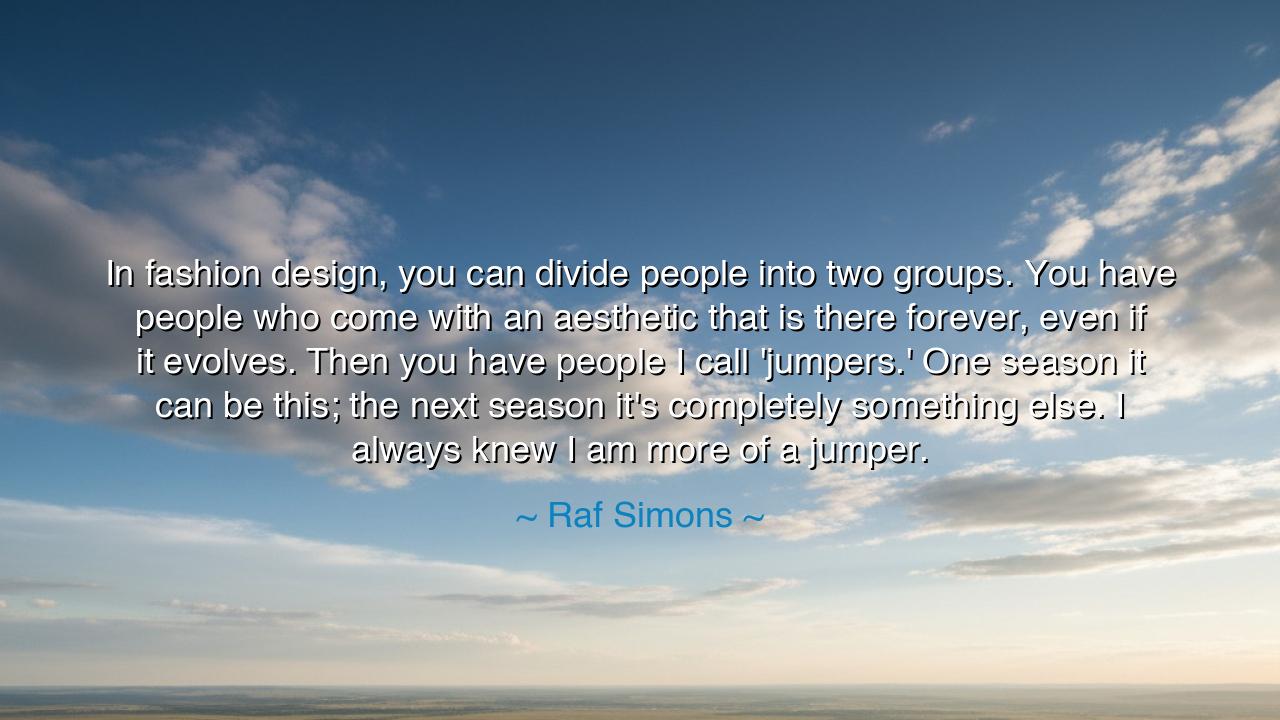
In fashion design, you can divide people into two groups. You
In fashion design, you can divide people into two groups. You have people who come with an aesthetic that is there forever, even if it evolves. Then you have people I call 'jumpers.' One season it can be this; the next season it's completely something else. I always knew I am more of a jumper.






“In fashion design, you can divide people into two groups. You have people who come with an aesthetic that is there forever, even if it evolves. Then you have people I call 'jumpers.' One season it can be this; the next season it's completely something else. I always knew I am more of a jumper.” Thus spoke Raf Simons, a creator whose words echo beyond the world of garments and fabric, reaching deep into the heart of human expression. His saying is not merely about fashion—it is a meditation on the nature of identity, change, and the eternal dance between stability and transformation. It is a reflection on how we, as makers and as souls, choose to live: either by holding fast to a single flame, or by leaping from spark to spark, kindling a thousand fires along our way.
In this teaching, Simons reveals the existence of two archetypes among creators. The first is the keeper of the aesthetic, the one who builds a temple and tends it all their life. Their vision remains steadfast, their principles unshaken, their work an ever-deepening echo of one truth. These are the creators like Coco Chanel, whose world of simplicity and elegance remained a steady constellation through decades of shifting trends. Such people move like rivers that carve the same bed over centuries—slow, faithful, and eternal. Their legacy is in continuity, in the unwavering refinement of a singular idea until it gleams like polished marble beneath the sun.
But then, there are the jumpers—those restless spirits who live not in the temples of consistency, but in the wild forests of evolution. They are the ones who leap from idea to idea, unafraid of contradiction, unafraid of rebirth. To be a jumper is to live many lives within one lifetime, to shed one skin and wear another with courage and curiosity. Raf Simons counts himself among them—a soul who refuses confinement, who seeks constant metamorphosis. His words are not confession, but celebration: for in the act of leaping, there is life; in the act of change, there is truth.
History remembers many such jumpers, those whose spirit could not be contained by a single form. Pablo Picasso, that eternal alchemist of art, began in the blues of sorrow, passed through the geometry of cubism, and ended in the abstraction of chaos. Critics often questioned him: “Who are you now, Picasso?” And he would answer not with words, but with paint—remaking himself as though rebirth were his calling. He did not fear inconsistency; he worshipped exploration. Like Simons, he understood that identity is not a fixed monument, but a living flame that must move to survive.
In these words, Simons also reveals a kind of spiritual honesty. To call oneself a jumper is to embrace impermanence, to admit that one’s truth is ever-shifting. It is to understand that the seasons of the soul mirror the seasons of the world—each one beautiful, each one fleeting. The ancient philosophers would have nodded at this, for they too spoke of the flux of existence. Heraclitus, the sage of Ephesus, declared: “You cannot step into the same river twice.” So too, says Simons, you cannot design the same collection, live the same day, or remain the same self. The stream flows onward, and the wise swim with it.
Yet, there is no shame in either path. The keepers preserve beauty; the jumpers expand it. One builds temples; the other builds horizons. One teaches the power of devotion, the other the courage of reinvention. The world needs both—the stillness of the mountain and the wind that dances upon its peaks. To scorn one is to misunderstand the balance that sustains creation itself. Simons’ words remind us that each soul must discover its rhythm, whether in constancy or in change, and honor it fully.
And what lesson shall we draw from this? It is this: Know thy nature, and walk boldly in it. If you are one whose spirit hungers for exploration, leap without fear; if you are one who seeks mastery through patience, dig your roots deep. Do not envy the other, for both are sacred ways of living. The key is not to copy the path of another, but to embrace your own evolution—to listen to the quiet pulse within you and follow where it leads, through chaos or calm.
So, my child of the future, whether you are a keeper or a jumper, do not stand idle. The world changes, and you must change with it—or against it—but always with purpose. For the truest art, like the truest life, is not made of stillness, but of movement. And whether your movement is a deepening spiral or a fearless leap, let it be your own.






AAdministratorAdministrator
Welcome, honored guests. Please leave a comment, we will respond soon